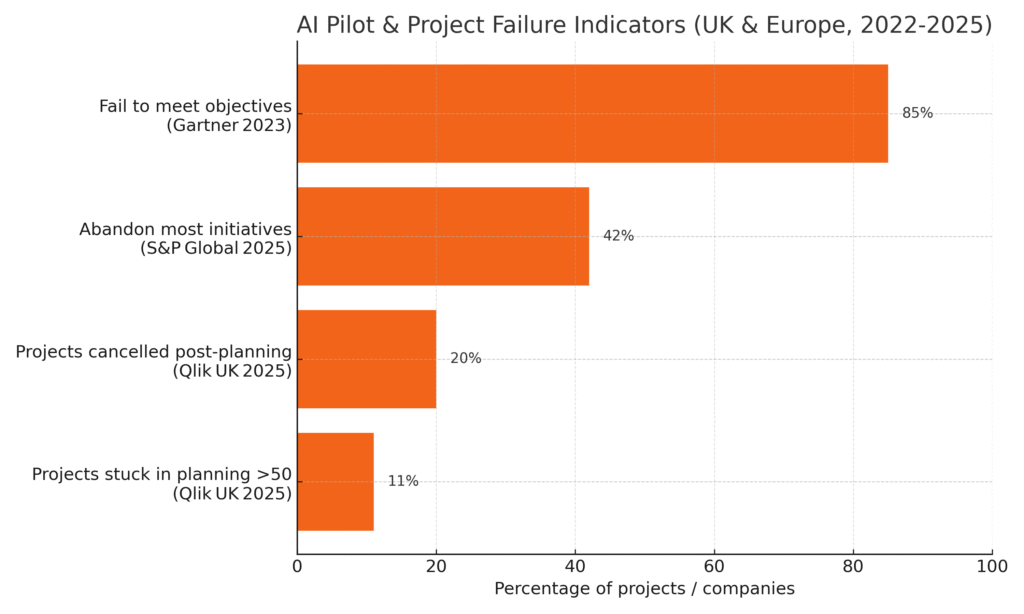Why many UK SMEs spend heavily before seeing any return
Most estimates place the prize for effective SME adoption of artificial intelligence at about £78 billion of additional UK GDP. Yet only thirty-seven percent of smaller firms say they have integrated AI into everyday operations. Behind that shortfall sit two stubborn facts: eighty-five percent of projects miss their stated objectives, and forty-two percent of European companies end up abandoning most initiatives. When pilots fail, budgets evaporate and teams lose appetite for further investment.
The readiness gap
Research commissioned by Microsoft shows that British SMEs recognise the value of automation and data-driven decision making but rarely know where to begin. Most pilots start with technology selection rather than a clear commercial problem. Without a defined outcome, scope creeps and proof-of-concept work drifts until momentum fades.
When pilots turn into unplanned costs
Figure 1 (see chart) compares four warning signs that projects are sliding off-track. Gartner reports that the vast majority of initiatives do not deliver the results set out in their business cases. S&P Global finds many firms simply walk away from AI efforts altogether, concluding that the original assumptions were unrealistic. Qlik’s United Kingdom survey adds two more danger signals: some organisations keep dozens of projects in permanent planning and others cancel after planning is complete, absorbing contractor fees and staff time with nothing to show for the spend. The average cancellation costs a mid-sized firm about £610,000.

Four cash-burning causes and practical fixes
Poor data quality forces teams to repeat cleansing work and rebuild pipelines. Seventy percent of failures trace directly to data issues. A rapid audit that maps where data lives and how reliable it is will surface these gaps early, allowing a phased pipeline plan before development begins.
A vague problem definition leads teams to optimise the wrong outcome. Up to eighty percent of 2023 pilots missed their commercial goals for that reason. A short outcome-first workshop, backed by simple return-on-investment modelling, keeps effort focused on measurable value.
A skills gap pushes organisations to rely on expensive external contractors. Only twenty-eight percent of SME leaders feel able to evaluate AI vendors confidently. Short literacy sessions for boards and a clear talent plan reduce dependence on day-rate specialists.
Misaligned budgets stall under-funded proofs of concept or allow over-funded experiments to sprawl. Forty-two percent of leaders cite shortages in funding or capacity as a key blocker.
Board-level confidence
Nearly half of UK directors say they lack confidence when assessing AI programmes. Projects slow when senior teams hesitate to release the next tranche of budget. Boards that receive clear, plain-language reporting on risk, compliance and commercial impact tend to approve decisions faster and with greater certainty.
A moving regulatory landscape
While the Information Commissioner’s Office has not yet fined a company specifically for poor AI governance, recent security-related penalties running to £3.07 million show the regulator’s willingness to act.
Our approach: A structured path to value
A structured readiness approach starts by building literacy, so leadership and key staff share a clear understanding of AI’s potential, risks and governance principles; this common language removes early uncertainty and aligns everyone on commercial goals. Discovery then provides an honest baseline of data quality, systems, skills and compliance, helping you see where value can be unlocked and where risks still sit. With facts on the table, we create a roadmap that sequences AI initiatives against business priorities and budget, giving you a phased plan you can fund with confidence. Finally, implementation support turns that plan into working solutions, guiding vendor selection, embedding governance and upskilling teams so improvements stick and scale. Together the four steps move you from curiosity to measurable results without the wasted spend that stalls many pilots.
Next step
If you are unsure where your organisation stands, start with our short questionnaires to assess data readiness, governance maturity and AI literacy. You will receive an instant score and tailored recommendations.
Ready to explore professional support? Visit the AI ORA Service page to see how our Readiness Accelerator turns those recommendations into phased, low-risk delivery.
Sources — Startups Magazine (2025); KPMG Customer Experience Excellence Report (2023, citing Gartner); Cybersecurity Dive / S&P Global (2025); Pixitech / Qlik survey (2025); Irish Examiner (2024); Startups.co.uk (2024); Informatica Blog (2025); Infosecurity Magazine (2024); Institute of Directors (2025).



